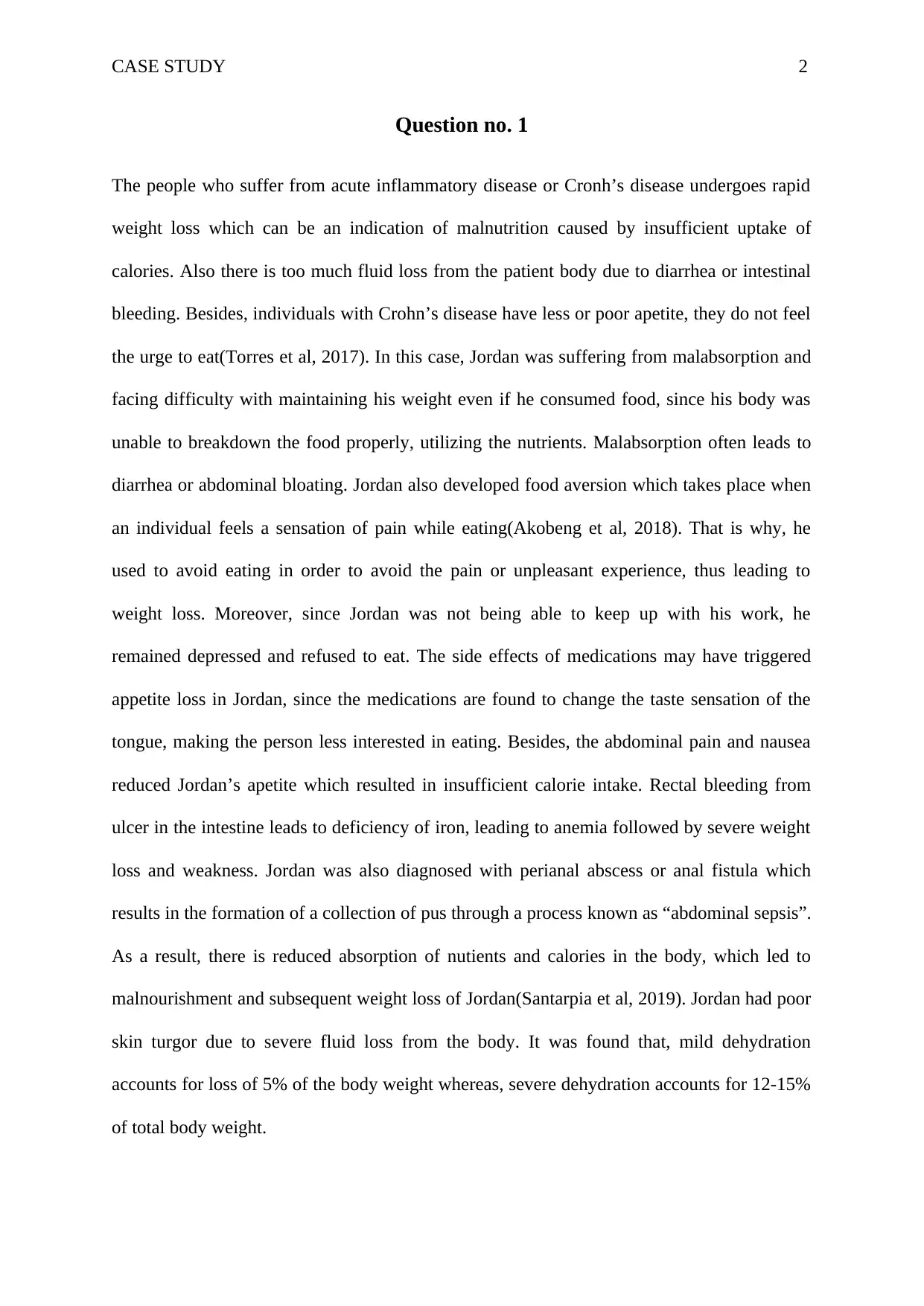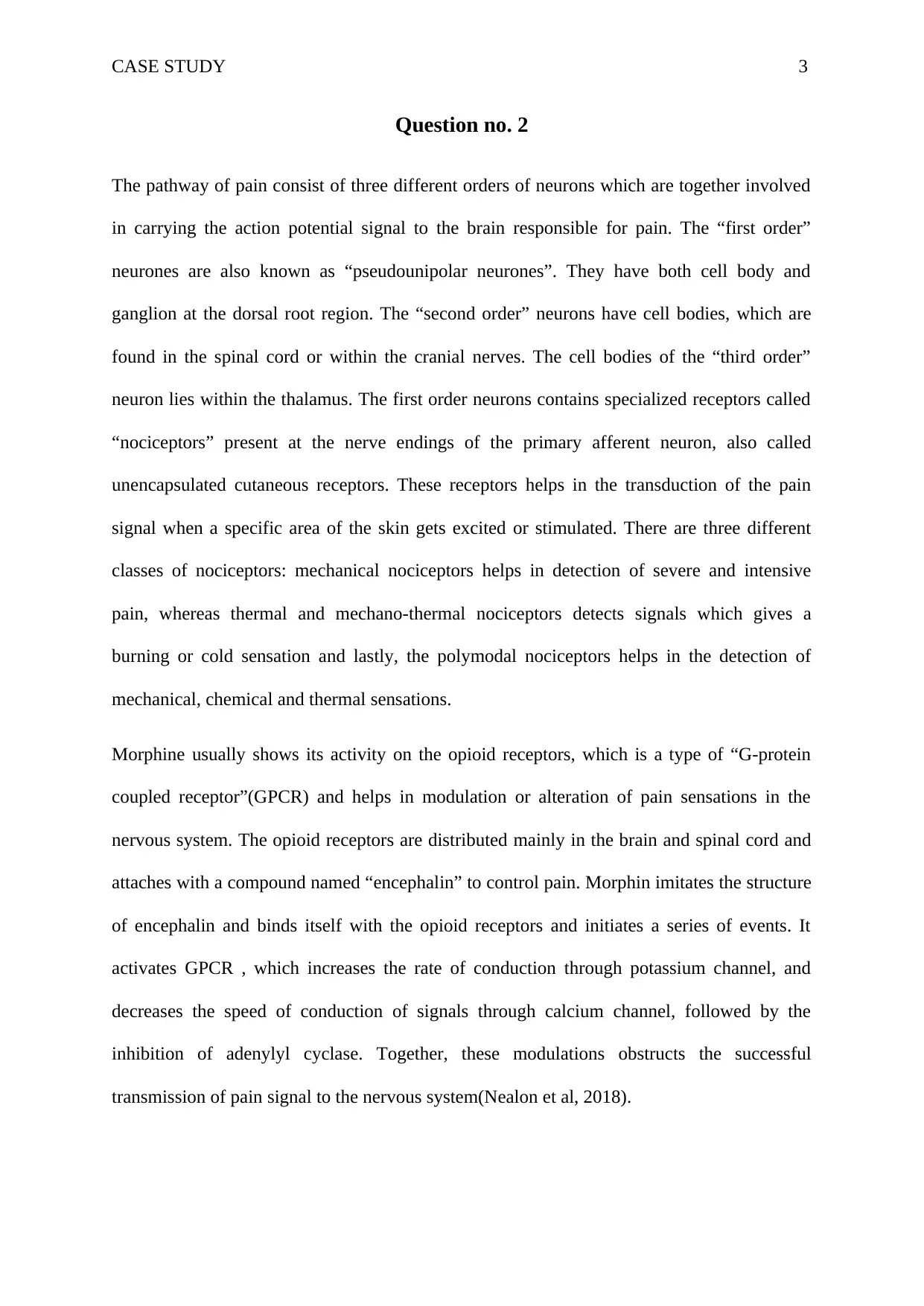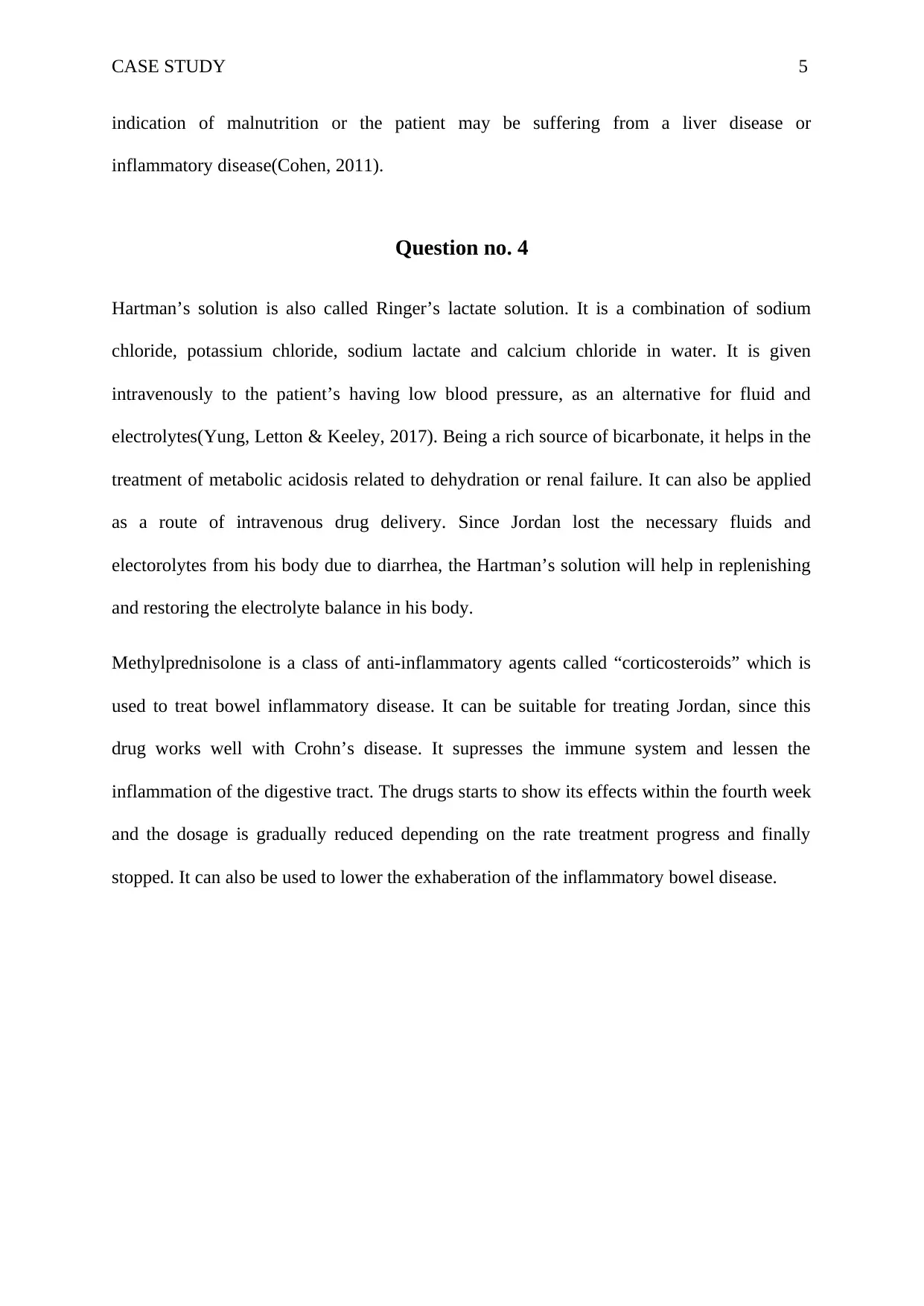Cronh’s disease | Case Study | Assignment
VerifiedAdded on 2022/08/31
|7
|1682
|16
AI Summary
Contribute Materials
Your contribution can guide someone’s learning journey. Share your
documents today.

Running head: CASE STUDY 1
Case Study
Name of the Student
Name of the University
Author Note
Case Study
Name of the Student
Name of the University
Author Note
Secure Best Marks with AI Grader
Need help grading? Try our AI Grader for instant feedback on your assignments.

CASE STUDY 2
Question no. 1
The people who suffer from acute inflammatory disease or Cronh’s disease undergoes rapid
weight loss which can be an indication of malnutrition caused by insufficient uptake of
calories. Also there is too much fluid loss from the patient body due to diarrhea or intestinal
bleeding. Besides, individuals with Crohn’s disease have less or poor apetite, they do not feel
the urge to eat(Torres et al, 2017). In this case, Jordan was suffering from malabsorption and
facing difficulty with maintaining his weight even if he consumed food, since his body was
unable to breakdown the food properly, utilizing the nutrients. Malabsorption often leads to
diarrhea or abdominal bloating. Jordan also developed food aversion which takes place when
an individual feels a sensation of pain while eating(Akobeng et al, 2018). That is why, he
used to avoid eating in order to avoid the pain or unpleasant experience, thus leading to
weight loss. Moreover, since Jordan was not being able to keep up with his work, he
remained depressed and refused to eat. The side effects of medications may have triggered
appetite loss in Jordan, since the medications are found to change the taste sensation of the
tongue, making the person less interested in eating. Besides, the abdominal pain and nausea
reduced Jordan’s apetite which resulted in insufficient calorie intake. Rectal bleeding from
ulcer in the intestine leads to deficiency of iron, leading to anemia followed by severe weight
loss and weakness. Jordan was also diagnosed with perianal abscess or anal fistula which
results in the formation of a collection of pus through a process known as “abdominal sepsis”.
As a result, there is reduced absorption of nutients and calories in the body, which led to
malnourishment and subsequent weight loss of Jordan(Santarpia et al, 2019). Jordan had poor
skin turgor due to severe fluid loss from the body. It was found that, mild dehydration
accounts for loss of 5% of the body weight whereas, severe dehydration accounts for 12-15%
of total body weight.
Question no. 1
The people who suffer from acute inflammatory disease or Cronh’s disease undergoes rapid
weight loss which can be an indication of malnutrition caused by insufficient uptake of
calories. Also there is too much fluid loss from the patient body due to diarrhea or intestinal
bleeding. Besides, individuals with Crohn’s disease have less or poor apetite, they do not feel
the urge to eat(Torres et al, 2017). In this case, Jordan was suffering from malabsorption and
facing difficulty with maintaining his weight even if he consumed food, since his body was
unable to breakdown the food properly, utilizing the nutrients. Malabsorption often leads to
diarrhea or abdominal bloating. Jordan also developed food aversion which takes place when
an individual feels a sensation of pain while eating(Akobeng et al, 2018). That is why, he
used to avoid eating in order to avoid the pain or unpleasant experience, thus leading to
weight loss. Moreover, since Jordan was not being able to keep up with his work, he
remained depressed and refused to eat. The side effects of medications may have triggered
appetite loss in Jordan, since the medications are found to change the taste sensation of the
tongue, making the person less interested in eating. Besides, the abdominal pain and nausea
reduced Jordan’s apetite which resulted in insufficient calorie intake. Rectal bleeding from
ulcer in the intestine leads to deficiency of iron, leading to anemia followed by severe weight
loss and weakness. Jordan was also diagnosed with perianal abscess or anal fistula which
results in the formation of a collection of pus through a process known as “abdominal sepsis”.
As a result, there is reduced absorption of nutients and calories in the body, which led to
malnourishment and subsequent weight loss of Jordan(Santarpia et al, 2019). Jordan had poor
skin turgor due to severe fluid loss from the body. It was found that, mild dehydration
accounts for loss of 5% of the body weight whereas, severe dehydration accounts for 12-15%
of total body weight.

CASE STUDY 3
Question no. 2
The pathway of pain consist of three different orders of neurons which are together involved
in carrying the action potential signal to the brain responsible for pain. The “first order”
neurones are also known as “pseudounipolar neurones”. They have both cell body and
ganglion at the dorsal root region. The “second order” neurons have cell bodies, which are
found in the spinal cord or within the cranial nerves. The cell bodies of the “third order”
neuron lies within the thalamus. The first order neurons contains specialized receptors called
“nociceptors” present at the nerve endings of the primary afferent neuron, also called
unencapsulated cutaneous receptors. These receptors helps in the transduction of the pain
signal when a specific area of the skin gets excited or stimulated. There are three different
classes of nociceptors: mechanical nociceptors helps in detection of severe and intensive
pain, whereas thermal and mechano-thermal nociceptors detects signals which gives a
burning or cold sensation and lastly, the polymodal nociceptors helps in the detection of
mechanical, chemical and thermal sensations.
Morphine usually shows its activity on the opioid receptors, which is a type of “G-protein
coupled receptor”(GPCR) and helps in modulation or alteration of pain sensations in the
nervous system. The opioid receptors are distributed mainly in the brain and spinal cord and
attaches with a compound named “encephalin” to control pain. Morphin imitates the structure
of encephalin and binds itself with the opioid receptors and initiates a series of events. It
activates GPCR , which increases the rate of conduction through potassium channel, and
decreases the speed of conduction of signals through calcium channel, followed by the
inhibition of adenylyl cyclase. Together, these modulations obstructs the successful
transmission of pain signal to the nervous system(Nealon et al, 2018).
Question no. 2
The pathway of pain consist of three different orders of neurons which are together involved
in carrying the action potential signal to the brain responsible for pain. The “first order”
neurones are also known as “pseudounipolar neurones”. They have both cell body and
ganglion at the dorsal root region. The “second order” neurons have cell bodies, which are
found in the spinal cord or within the cranial nerves. The cell bodies of the “third order”
neuron lies within the thalamus. The first order neurons contains specialized receptors called
“nociceptors” present at the nerve endings of the primary afferent neuron, also called
unencapsulated cutaneous receptors. These receptors helps in the transduction of the pain
signal when a specific area of the skin gets excited or stimulated. There are three different
classes of nociceptors: mechanical nociceptors helps in detection of severe and intensive
pain, whereas thermal and mechano-thermal nociceptors detects signals which gives a
burning or cold sensation and lastly, the polymodal nociceptors helps in the detection of
mechanical, chemical and thermal sensations.
Morphine usually shows its activity on the opioid receptors, which is a type of “G-protein
coupled receptor”(GPCR) and helps in modulation or alteration of pain sensations in the
nervous system. The opioid receptors are distributed mainly in the brain and spinal cord and
attaches with a compound named “encephalin” to control pain. Morphin imitates the structure
of encephalin and binds itself with the opioid receptors and initiates a series of events. It
activates GPCR , which increases the rate of conduction through potassium channel, and
decreases the speed of conduction of signals through calcium channel, followed by the
inhibition of adenylyl cyclase. Together, these modulations obstructs the successful
transmission of pain signal to the nervous system(Nealon et al, 2018).

CASE STUDY 4
Question no. 3
The condition of Jordan was deteriorating on a daily bais. His blood pressure reading shows
92/52 mm/hg, which signifies a sudden drop in his blood pressure owing to hypotension. A
low blood pressure can be detrimental for the body and can make the person feel fatigued,
tired due to lack of energy. His pulse rate increased to 112 beats per minute which is well
above the normal pulse rate of 60-70 beats per min. This can be a sign of sinus tachycardia.
Moreover, he had weak peripheral pulses which can be caused by reduced blood flow to the
vital organs(Cgp Books, & Cgp Books, 2012). His respiratory rate was recorded around 24
breaths per minute which is above the normal range (20 breath per minute) indicating a panic
attack or increased anxiety and stress. His body temperature was around 38.3oC which
clearly indicates that Jordan must be suffering from fever. Although the oxygen saturation
level seemed to be normal, his weight was below average, since the normal average weight of
a 25 years old male having a height of 188 cm should have been around 82 kilograms. Lastly
on performing urinalysis, the appearance of the urine was dark with a very high specific
gravity, around 1035, which can be a clear indication of renal infection or pyelonephritis. On
further pathological examination, it was found that his haemoglobin level was around 109g/
litre, which indicated that Jordan might be suffering from moderate anemia. The haematocrit
value was 51% which is higher than the normal range of 35-47%, this is a sign of
dehydration. The Erythrocyte segmentation rate was found abnormally high (26.5mm/hour)
which is a sign of inflammation in the body. The amount of C-reactive protein was found to
be about 30.7mg/dl which is higher than the normal value (20mg/dl). A high value of C-
reactive protein can be a sign of inflammation of the arteries in the heart, which may increase
the risk of myocardial infaction(Hawkey, 2012). The concentration of albumin the blood was
found to be 30.5g/litre, which is below the normal range (35-50 g/litre). This can be a clear
Question no. 3
The condition of Jordan was deteriorating on a daily bais. His blood pressure reading shows
92/52 mm/hg, which signifies a sudden drop in his blood pressure owing to hypotension. A
low blood pressure can be detrimental for the body and can make the person feel fatigued,
tired due to lack of energy. His pulse rate increased to 112 beats per minute which is well
above the normal pulse rate of 60-70 beats per min. This can be a sign of sinus tachycardia.
Moreover, he had weak peripheral pulses which can be caused by reduced blood flow to the
vital organs(Cgp Books, & Cgp Books, 2012). His respiratory rate was recorded around 24
breaths per minute which is above the normal range (20 breath per minute) indicating a panic
attack or increased anxiety and stress. His body temperature was around 38.3oC which
clearly indicates that Jordan must be suffering from fever. Although the oxygen saturation
level seemed to be normal, his weight was below average, since the normal average weight of
a 25 years old male having a height of 188 cm should have been around 82 kilograms. Lastly
on performing urinalysis, the appearance of the urine was dark with a very high specific
gravity, around 1035, which can be a clear indication of renal infection or pyelonephritis. On
further pathological examination, it was found that his haemoglobin level was around 109g/
litre, which indicated that Jordan might be suffering from moderate anemia. The haematocrit
value was 51% which is higher than the normal range of 35-47%, this is a sign of
dehydration. The Erythrocyte segmentation rate was found abnormally high (26.5mm/hour)
which is a sign of inflammation in the body. The amount of C-reactive protein was found to
be about 30.7mg/dl which is higher than the normal value (20mg/dl). A high value of C-
reactive protein can be a sign of inflammation of the arteries in the heart, which may increase
the risk of myocardial infaction(Hawkey, 2012). The concentration of albumin the blood was
found to be 30.5g/litre, which is below the normal range (35-50 g/litre). This can be a clear
Secure Best Marks with AI Grader
Need help grading? Try our AI Grader for instant feedback on your assignments.

CASE STUDY 5
indication of malnutrition or the patient may be suffering from a liver disease or
inflammatory disease(Cohen, 2011).
Question no. 4
Hartman’s solution is also called Ringer’s lactate solution. It is a combination of sodium
chloride, potassium chloride, sodium lactate and calcium chloride in water. It is given
intravenously to the patient’s having low blood pressure, as an alternative for fluid and
electrolytes(Yung, Letton & Keeley, 2017). Being a rich source of bicarbonate, it helps in the
treatment of metabolic acidosis related to dehydration or renal failure. It can also be applied
as a route of intravenous drug delivery. Since Jordan lost the necessary fluids and
electorolytes from his body due to diarrhea, the Hartman’s solution will help in replenishing
and restoring the electrolyte balance in his body.
Methylprednisolone is a class of anti-inflammatory agents called “corticosteroids” which is
used to treat bowel inflammatory disease. It can be suitable for treating Jordan, since this
drug works well with Crohn’s disease. It supresses the immune system and lessen the
inflammation of the digestive tract. The drugs starts to show its effects within the fourth week
and the dosage is gradually reduced depending on the rate treatment progress and finally
stopped. It can also be used to lower the exhaberation of the inflammatory bowel disease.
indication of malnutrition or the patient may be suffering from a liver disease or
inflammatory disease(Cohen, 2011).
Question no. 4
Hartman’s solution is also called Ringer’s lactate solution. It is a combination of sodium
chloride, potassium chloride, sodium lactate and calcium chloride in water. It is given
intravenously to the patient’s having low blood pressure, as an alternative for fluid and
electrolytes(Yung, Letton & Keeley, 2017). Being a rich source of bicarbonate, it helps in the
treatment of metabolic acidosis related to dehydration or renal failure. It can also be applied
as a route of intravenous drug delivery. Since Jordan lost the necessary fluids and
electorolytes from his body due to diarrhea, the Hartman’s solution will help in replenishing
and restoring the electrolyte balance in his body.
Methylprednisolone is a class of anti-inflammatory agents called “corticosteroids” which is
used to treat bowel inflammatory disease. It can be suitable for treating Jordan, since this
drug works well with Crohn’s disease. It supresses the immune system and lessen the
inflammation of the digestive tract. The drugs starts to show its effects within the fourth week
and the dosage is gradually reduced depending on the rate treatment progress and finally
stopped. It can also be used to lower the exhaberation of the inflammatory bowel disease.

CASE STUDY 6
REFERENCE
Akobeng, A. K., Zhang, D., Gordon, M., & MacDonald, J. K. (2018). Enteral nutrition for
maintenance of remission in Crohn's disease. Cochrane database of systematic
reviews, (8).
Cgp Books, & Cgp Books. (2012). New a-level biology for aqa.
Cohen, R. (2011). Inflammatory bowel disease. Humana.
Hawkey, C. (2012). Textbook of clinical gastroenterology and hepatology. Wiley-Blackwell.
Nealon, C. M., Patel, C., Worley, B. L., Henderson-Redmond, A. N., Morgan, D. J., &
Czyzyk, T. A. (2018). Alterations in nociception and morphine antinociception in
mice fed a high-fat diet. Brain research bulletin, 138, 64-72.
Santarpia, L., Alfonsi, L., Castiglione, F., Pagano, M. C., Cioffi, I., Rispo, A., ... & Pasanisi,
F. (2019). Nutritional Rehabilitation in Patients with Malnutrition Due to Crohn’s
Disease. Nutrients, 11(12), 2947.
Torres, J., Mehandru, S., Colombel, J. F., & Peyrin-Biroulet, L. (2017). Crohn's disease. The
Lancet, 389(10080), 1741-1755.
Yung, M., Letton, G., & Keeley, S. (2017). Controlled trial of Hartmann's solution versus
0.9% saline for diabetic ketoacidosis. Journal of paediatrics and child health, 53(1),
12-17.
REFERENCE
Akobeng, A. K., Zhang, D., Gordon, M., & MacDonald, J. K. (2018). Enteral nutrition for
maintenance of remission in Crohn's disease. Cochrane database of systematic
reviews, (8).
Cgp Books, & Cgp Books. (2012). New a-level biology for aqa.
Cohen, R. (2011). Inflammatory bowel disease. Humana.
Hawkey, C. (2012). Textbook of clinical gastroenterology and hepatology. Wiley-Blackwell.
Nealon, C. M., Patel, C., Worley, B. L., Henderson-Redmond, A. N., Morgan, D. J., &
Czyzyk, T. A. (2018). Alterations in nociception and morphine antinociception in
mice fed a high-fat diet. Brain research bulletin, 138, 64-72.
Santarpia, L., Alfonsi, L., Castiglione, F., Pagano, M. C., Cioffi, I., Rispo, A., ... & Pasanisi,
F. (2019). Nutritional Rehabilitation in Patients with Malnutrition Due to Crohn’s
Disease. Nutrients, 11(12), 2947.
Torres, J., Mehandru, S., Colombel, J. F., & Peyrin-Biroulet, L. (2017). Crohn's disease. The
Lancet, 389(10080), 1741-1755.
Yung, M., Letton, G., & Keeley, S. (2017). Controlled trial of Hartmann's solution versus
0.9% saline for diabetic ketoacidosis. Journal of paediatrics and child health, 53(1),
12-17.

CASE STUDY 7
1 out of 7
Related Documents
Your All-in-One AI-Powered Toolkit for Academic Success.
+13062052269
info@desklib.com
Available 24*7 on WhatsApp / Email
![[object Object]](/_next/static/media/star-bottom.7253800d.svg)
Unlock your academic potential
© 2024 | Zucol Services PVT LTD | All rights reserved.





